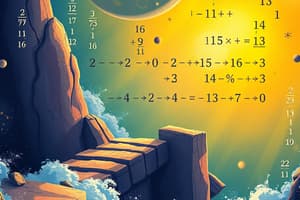Podcast
Questions and Answers
Which operation is the inverse of addition?
Which operation is the inverse of addition?
- Division
- Multiplication and Division
- Multiplication
- Subtraction (correct)
Multiplying a number by 2 is the same as doubling that number.
Multiplying a number by 2 is the same as doubling that number.
True (A)
What visual representation can be used to show the relationship between multiplication and division?
What visual representation can be used to show the relationship between multiplication and division?
Arrays or number lines
A fraction represents a part of a __________.
A fraction represents a part of a __________.
Match the following units of measurement with their categories:
Match the following units of measurement with their categories:
Which of the following fractions is equal to 0.5?
Which of the following fractions is equal to 0.5?
In algebra, variables are used to represent fixed numbers.
In algebra, variables are used to represent fixed numbers.
What strategy can be used for efficient calculation when dividing by 2?
What strategy can be used for efficient calculation when dividing by 2?
Flashcards are hidden until you start studying
Study Notes
AC9M5ST02: Representing and Solving Problems Involving Addition and Subtraction
- Understand the concept of addition and subtraction as inverse operations.
- Use visual representations (e.g., number lines, counters) to illustrate addition and subtraction.
- Formulate and solve word problems involving addition and subtraction.
- Develop strategies for mental calculations and estimation.
AC9M5ST03: Representing and Solving Problems Involving Multiplication and Division
- Grasp the relationship between multiplication and division.
- Use arrays, area models, and number lines to represent multiplication and division.
- Formulate and solve real-life problems using multiplication and division.
- Explore various strategies for efficient calculations, including doubling and halving.
AC9M5M01: Understanding Fractions and Decimals
- Recognize fractions as parts of a whole and decimals as a way of expressing fractions.
- Compare and order fractions and decimals.
- Convert between fractions and decimals.
- Solve problems involving addition, subtraction, multiplication, and division of fractions and decimals.
AC9M5M02: Understanding the Concept of Measurement
- Identify and use standard units of measurement (length, area, volume, mass).
- Apply measurement concepts in real-life contexts.
- Understand the relationship between different units within the same measurement system (e.g., cm to m).
- Develop skills in estimating and measuring accurately using appropriate tools.
AC9M5M03: Understanding Patterns and Algebra
- Recognize and extend numerical patterns.
- Understand the concept of variables and simple algebraic expressions.
- Use symbols to represent numbers and relationships.
- Solve simple equations and inequalities, demonstrating an understanding of balance and equality.
General Tips
- Practice solving real-life problems to reinforce understanding.
- Use visual aids and manipulatives to enhance comprehension.
- Engage in collaborative learning through group activities.
- Regularly review concepts to build a strong mathematical foundation.
Addition and Subtraction Concepts
- Addition and subtraction are inverse operations crucial for problem-solving.
- Visual tools like number lines and counters help illustrate these operations.
- Word problems must be formulated and solved to apply addition and subtraction in context.
- Mental calculations and estimation strategies enhance numerical fluency.
Multiplication and Division Concepts
- Multiplication and division are interconnected; understanding one aids the other.
- Utilize arrays, area models, and number lines for representing these operations visually.
- Real-life applications involve formulating and solving problems based on multiplication and division.
- Efficient calculation strategies include methods like doubling and halving for quicker results.
Understanding Fractions and Decimals
- Fractions represent parts of a whole, while decimals are fractional expressions in another format.
- Comparing and ordering fractions and decimals is essential for understanding their relationships.
- Converting between fractions and decimals is a key skill in arithmetic.
- Problem-solving includes operations (addition, subtraction, multiplication, division) with both fractions and decimals.
Measurement Concepts
- Standard units (length, area, volume, mass) are vital for accurate measurement.
- Application of measurement concepts is common in daily life, enhancing relevance.
- Understanding unit relationships (e.g., converting cm to m) is crucial within the same measurement system.
- Skills in estimation and accurate measurement with tools are important for practical applications.
Patterns and Algebra Understanding
- Recognizing and extending numerical patterns aids mathematical reasoning.
- Variables and simple algebraic expressions introduce foundational algebra concepts.
- Symbols are used to represent numbers and relationships, facilitating equation solving.
- Understanding balance and equality is key to solving simple equations and inequalities.
General Study Tips
- Practice with real-life problem-solving scenarios reinforces theoretical knowledge.
- Utilize visual aids and manipulatives to enhance understanding of complex concepts.
- Engage in group activities to benefit from collaborative learning.
- Regularly review learned concepts to solidify a strong mathematical foundation.
Studying That Suits You
Use AI to generate personalized quizzes and flashcards to suit your learning preferences.




